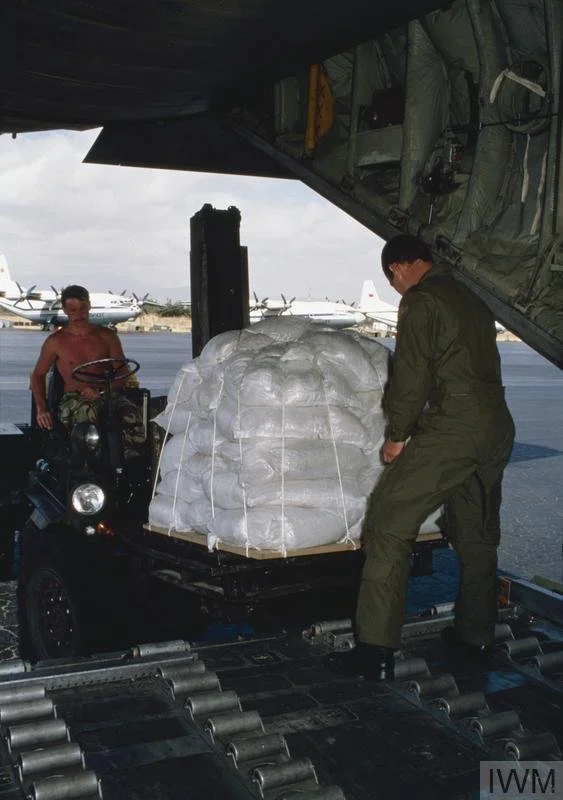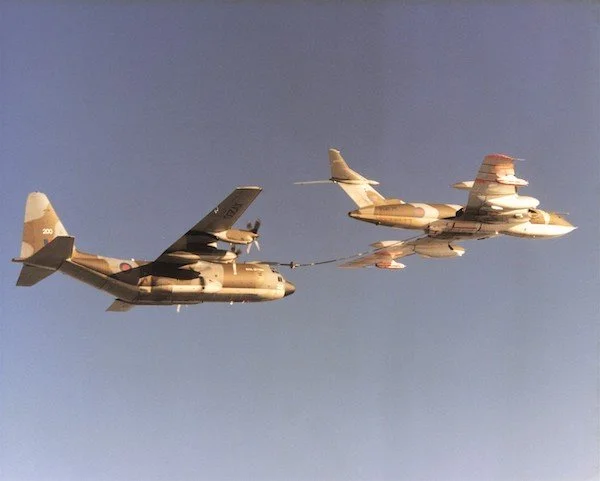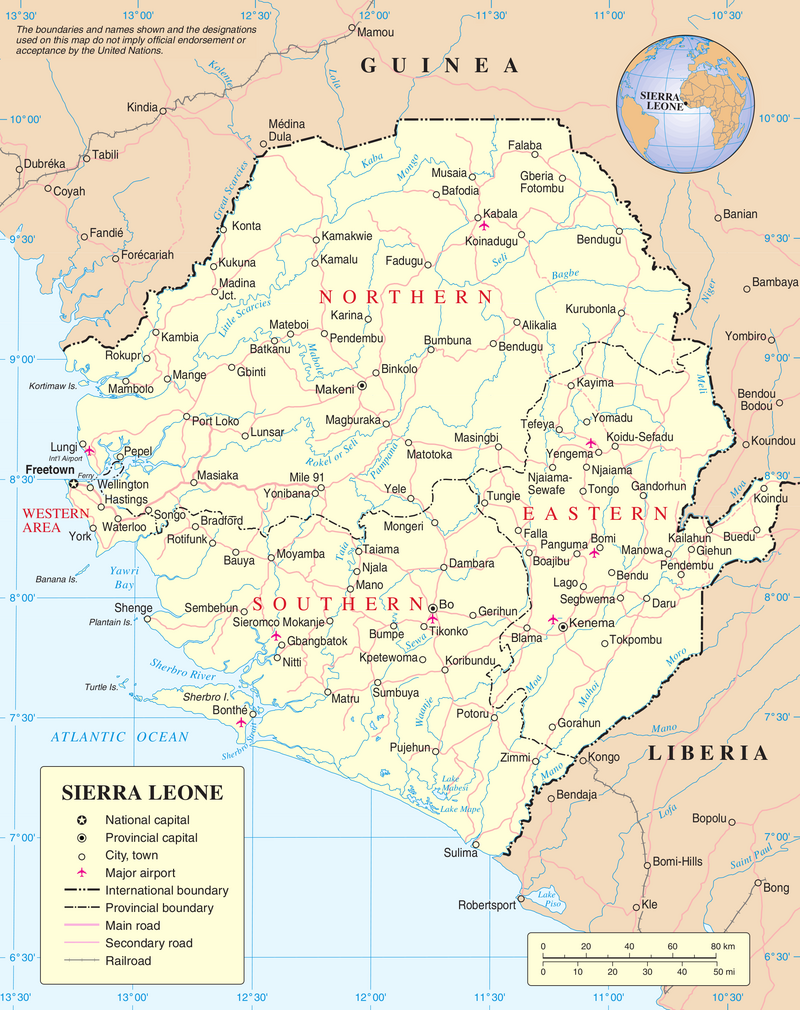Chapter VII - Hercules C130 1968 - 2016
The Hercules 1968 - 2016
Reforming in June 1968 at RAF Fairford with Lockheed Hercules aircraft, 30 Sqn operated from there until it moved to RAF Lyneham in 1971. The Hercules, as a tactical transport aircraft with strategic capabilities has enabled 30 Sqn crews to roam the world on a routine basis from 1968 onwards.
The utility of the Hercules squadrons saw them involved in numerous humanitarian relief operations across the globe. This included in early 1973, Hercules' from the Lyneham Wing involved in the RAF's largest airlift since Berlin when some 2,000 tons of grain, rice and maize were air dropped to remote villages in Nepal during Operation Khana Cascade.
In the early days of the Hercules 30 Sqn took part in operations such as ‘KHANA CASCADE’ in 1973, where food was airlifted to starving Nepalese in the Himalayas. All the supplies had to be taken to remote landing strips or drop zones where the precipitous terrain and extremes of climate and altitude left little margin for error. Eleven years later in 1984, 30 Sqn was again engaged in a similar operation. This time Operation BUSHEL which involved ferrying food and aid to millions of starving Ethiopians.
RAF Hercules participated in an emergency airlift of food and supplies to Ethiopia in the wake of severe drought, famine and civil war (Operation BUSHEL). During the deployment, the Hercules detachment flew 1,198 air-landing sorties and 954 air-dropping sorties; 17,788 tonnes of supplies were air-landed and a further 14,380 tonnes air-dropped.
Of note, prior to 1985, 30 Sqn had been involved in a wide variety of operations including the Dacca Airlift, Philippines and Nicaragua Flood relief, Cyprus evacuation, Belize reinforcement, Rhodesia Monitoring force and Operation Corporate
Falklands War 1982
Operation CORPORATE was mounted in April 1982 in response to the Argentinian invasion of the Falkland Islands. From the outset 30 Sqn was involved with crews flying vital supplies to Ascension Island even before the task force ships had steamed out of Portsmouth. At the same time, crews commenced training on the first Hercules tankers in RAF Service.
There were two refuelling brackets on a southbound airbridge flight involving three aircraft: two Hercs and a Victor. This photo (taken by the Herc tanker crew) shows the freighter (the one going all the way to the Falkland Islands) and the Victor at bracket 1, two hours south of Ascension. After about six hours of flying at bracket 2, the Herc tanker would top the freighter up again giving the freighter enough fuel to be able to divert if the weather in the Falklands was very poor. After this refuel the tanker would turn around and fly six hours back to Ascension. The closest diversion for the freighter was Montevideo - five hours away!
The Hercules tankers were used to augment the Victor tankers at Ascension. The Hercules continued to maintain a unique airbridge which carried passengers and freight over 4,000 miles between Ascension and the Falklands, flying daily in support of ground and air defence forces. The task demanded the highest professional standards of the crews, as demonstrated in March 1984 when a 30 Sqn Hercules, captained by Flt Lt Bill Akister, was forced either to land at Ascension at the height of a fearsome tropical storm or face the equally fearsome alternative of ditching. The aircraft landed safely and the captain was awarded the ‘Queen’s Commendation for Valuable Services in the Air’ for his achievement.
The Sqn’s commitment to help to maintain the airbridge to the Falklands endured for a number of years, lessening somewhat with the advent of the Tristar schedule to Mount Pleasant in May 1987. However, by this point the number of exercises that were tasked were straining the Sqn’s resources, with Ex AURORA EXPRESS for example requiring eight crews to deploy to Turkey.
By 1989 the support to Op CORPORATE had diminished to only 10% of the Sqn’s task and the final tanker support flight to the airbridge out of Ascension was flown. In March 1990 the RAF Hercules fleet had achieved the milestone of one million flying hours and a composite crew from the four squadrons and the Operational Conversion Unit flew a commemorative sortie.
Iraq 1990-1991
30 Sqn were closely involved during Op GRANBY following the invasion of Kuwait by Iraqi forces in 1990. Crews were heavily tasked transporting the immense amount of equipment and supplies required for the UK’s contribution to coalition force, working extended crew duty days with minimum time off between flights. In both August and September the Sqn flew over 1200hrs in support of GRANBY and flying reached a peak in October when 1326hrs were flown on this operation alone.
With commencement of combat forces in 1991 almost every crew on the Sqn were at some time subjected to air attack while unloading at airfields in the Gulf. One crew whilst flying over Riyadh in cloud during an air raid were disconcerted to observe the trails of Scud missiles falling around their aircraft! During this period many crews exceeded 115hrs per month. Following the liberation of Kuwait the emphasis turned to relief flights for Kurdish refugees displaced by Saddam Hussein as part of Op HAVEN. As part of the recovery of troops and equipment on 14 June a crew landed at Sirsenk in Iraq, becoming the first crew from 30 Sqn to set foot in Iraq since 1939. They would not be the last.
The Balkans, Iraq and Rwanda 1992-1993
As things slowly began to return to normal the first rumblings of trouble in the Balkans highlighted the more turbulent order of the post-Cold War world. In April 1992, 30 Sqn flew the first contingent of British troops to Belgrade in Yugoslavia to join the UN peace-keeping force. Crews made regular resupply flights in support of this force under Op GRAPPLE whilst whilst continuing to support the no-fly zones over northern and southern Iraq under Op JURAL. In April 1993 crews began supporting the deployment of Tornados to Gioia del Colle in Italy for Op DENY FLIGHT, the establishment of a no-fly zone over Bosnia and Herzegovina. 1994 saw the Sqn involved in two civil wars, the first lifting British expatriates from the Yemen, the second delivering humanitarian aid to Rwanda, which had endured a terrible genocide. The following year saw the Sqn’s involvement in the former Yugoslavia increase substantially as the UK’s commitment there grew under Op GRAPPLE and RESOLUTE, the latter christened Op DENY CHRISTMAS as NATO took over in December following the end of the UN peace-keeping mission.
After nearly fifteen years of service in the Falklands the Hercules tankers were withdrawn in March 1996 and their role was taken over by the VC10s. Crews from 30 Sqn began six-week detachments in place of the four-month ones they had been maintaining previously. In late 1997 Saddam Hussein once again provoked by denying access to UN inspection teams in Iraq and as a result, Operation BOLTON was set up to reinforce UK forces in the region. Crews were involved in the resupply of HMS Invincible at Gibraltar followed by support to a further deployment of Tornados to Ali al Salem Air Base in Kuwait. Op BOLTON continued through to May 1998, with a further resurgence of activity in December when crews were tasked to carry bombs to Kuwait for the Tornados who were once again supporting the Allied bombing effort again Saddam. Op DESERT FOX involved extended slip patterns that should have kept the crews busy through until the New Year but in the event, the bombing was halted and all returned home on Christmas Eve. In total during 1998, 30 Sqn flew 7700hrs in support of operations, on exercise and in continuation training, the Middle East accounting for most of the operational tasking.
The Strategic Role and Kosovo 1999
In January 1999, 30 Sqn along with XXIV Sqn lost its limited but significant transport support capability and from this date - no more low-level training was carried out and no more crews were detached to 1312 Flt at Mount Pleasant. It would not be until the advent of the C-130J that the Sqn would regain its tactical support role.
Soon, ever increasing tensions in Kosovo rapidly slid into war, with NATO carrying out an extensive bombing campaign against the Serbs. This would prove to be the busiest period at Lyneham and on 30 Sqn since the Gulf War. Support to Operation AGRICOLA continued through until July as offensive operations morphed into peacekeeping. No sooner had one trouble spot died down when another exploded, this time in East Timor in Indonesia after the population had voted for independence. Several crews supported the British contingent of the UN Force sent to control the violence that erupted there.
Sierra Leone 2000
During May 2000 Operation PALLISER was carried out to move personnel to Freetown in Sierra Leone. This would eventually involve fifteen crews operating in a slip pattern based in Dakar, Senegal. After members of the Royal Irish Regiment were take hostage by militias, Operation BARRASS was launched to mount a rescue mission. The Sqn’s Commanding Officer at the time was Wg Cdr John Barrass (Dep Chair of the Association) who thus has the distinction of being the Squadron’s only Commanding Officer to have an operation named after him!



